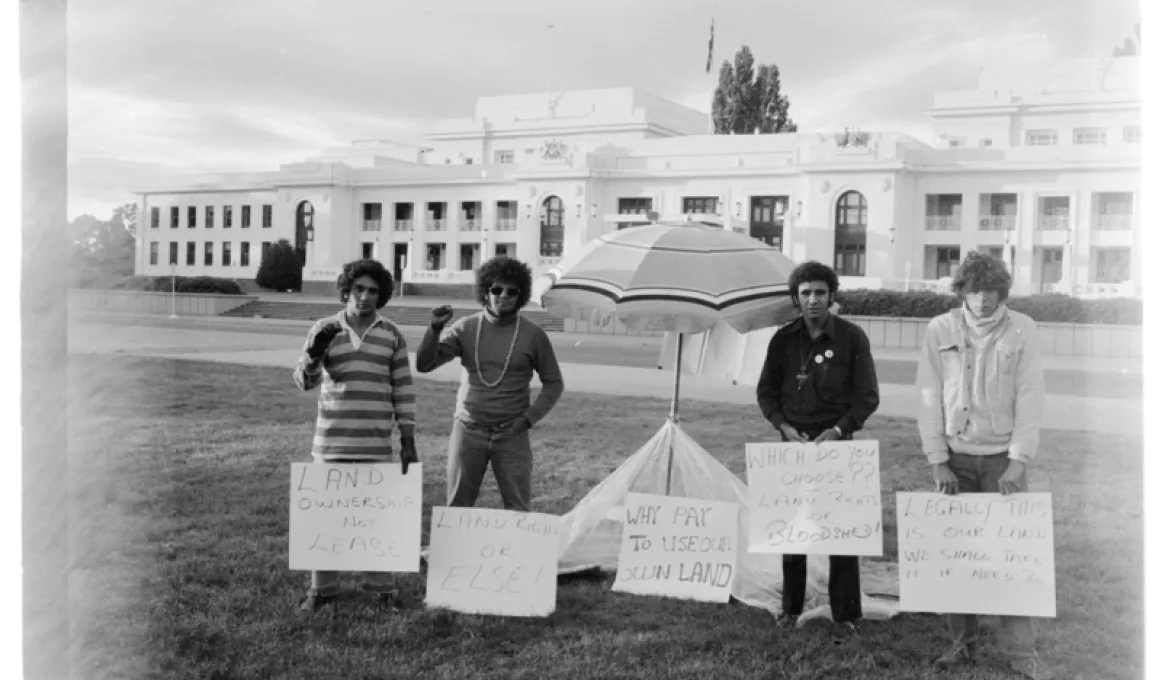50th Anniversary of the Aboriginal Tent Embassy

The Aboriginal Tent Embassy began with a beach umbrella on 26 January 1972, erected by 4 Aboriginal men from Redfern in Sydney.
On 26 January 1972, four Aboriginal men established the Aboriginal Embassy under a beach umbrella on the lawn opposite what is now Old Parliament House.
They were Michael Anderson, Billy Craigie, Bertie Williams and Tony Coorey from Redfern in Sydney.
This was in response to the Australian government’s approach to Aboriginal land rights.
‘On the eve of Australia Day 1972, the McMahon government announced the implementation of a new system that rejected granting independent ownership of traditional land to Indigenous people in favour of 50-year general purpose leases for Indigenous communities, provided they could demonstrate a social and economic use for the land and excluding any mineral and forest rights.’1
The Aboriginal Embassy symbolised the effect the policy had on Indigenous Australians. As Aboriginal activist Gary Foley said, ‘Aborigines are treated like aliens in their own land.’2 Therefore, they needed an embassy.
The Aboriginal Tent Embassy, as it became known, inspired many more protesters to assemble in Canberra. The protesters included university students and high profile First Nations activists. By April, at least 8 tents were erected.
The protest attracted national and even international media attention.
In June of 1972, new laws made the encampment illegal and on Thursday 20 July, hundreds of protesters clashed with police. Many protesters were arrested and the tents were removed.
The next Sunday, protesters again erected embassy tents. This resulted in another clash with police and the tents were removed for a second time.
On 30 July more than 2000 people were present when the tents were re-erected then removed by protesters in a peaceful demonstration.
‘In September 1972, the ACT Supreme Court ruled against the…… eviction of the Embassy, which was then re-erected and removed again by the diplomatic staff [protesters] in symbolic enaction of their rights. Late in 1973, after the Whitlam government was elected (and persuaded to meet with embassy representatives), the tents were pitched again.’3
The Embassy stood until 1976 when it was dismantled following the introduction of the Aboriginal Land Rights Act of 1976 which was instigated by the Whitlam Government in mid-1975 and passed with bipartisan support by the Fraser government in December 1976.
The protest site moved around to various places in Canberra before returning to the original and current site in 1992.
‘In 1995 the embassy itself was listed on the Register of the National Estate; the only site on the Register noted as important due to its political significance to Indigenous Australians.’4
The Embassy, now a permanent building, has suffered condemnation and even arson attacks over the years but to this day remains a symbol of Aboriginal protest.
1. Aboriginal Tent Embassy | National Museum of Australia (nma.gov.au)
2. Activists at the Aboriginal Tent Embassy on the lawns of Old Parliament House | naa.gov.au
3. Tent Embassy (unimelb.edu.au)
4. Aboriginal Tent Embassy | National Museum of Australia (nma.gov.au)
Find out more
For more information, see Aboriginal Tent Embassy and Timeline: Aboriginal Tent Embassy.